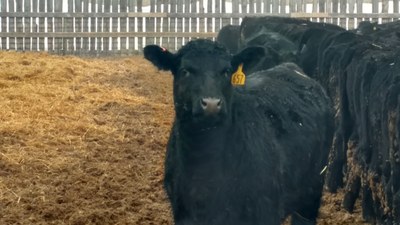Synchronizing Protocols for Breeding Cows and Heifers
There are many advantages to synchronizing breeding in the cow herd:
- Breeding to high accuracy bulls via artificial insemination
- Grouping cows to calve within a shorter calving period
- Reducing estrus detection labor by breeding cattle on timed artificial insemination protocols
- Better feeding management when stage of gestation is known via breeding date
Improved conception results occur when cattle are on an increasing plane of nutrition, reduced stress or movement, no diet changes, and following synchronization protocols closely.
Sometimes producers express dismay when conception rates to timed AI (artificial insemination) are only 50%. Realistically, 60-70% is rather good and exceptional is when 80% conception rates to timed AI are achieved. Synchronization protocols have best success when strictly followed. You can read more about maximizing pregnancy rates when using AI here.

Beef Heifer
The Beef Reproduction Task Force has researched and compiled various synchronization protocols. These protocols are slightly different between cows and heifers and can be viewed at http://beefrepro.unl.edu/resources.html
For cows, the short-term Fixed-Time AI protocols are either ‘7-day CO-Synch + CIDR’ or ‘5-day CO-Synch + CIDR’.
The short-term ‘7-day CO-Synch + CIDR’ protocol starts with insertion of a CIDR and an injection of GnRH (gonadotrophin releasing hormone) on day 0. On Day 7, the CIDR is removed and an injection of Prostaglandin F2 alpha is given. At 60 to 66 hours later, all cows are injected with GnRH and artificial inseminated. Protocol length: 10 days
For heifers, the short-term Fixed-Time AI protocols are either ‘7-day CO-Synch + CIDR’ or ‘5-day CO-Synch + CIDR’:
The short-term ‘7-day CO-Synch + CIDR‘ protocol starts with insertion of a CIDR and an injection of GnRH (gonadotrophin releasing hormone) on day 0. On Day 7, the CIDR is removed and an injection of Prostaglandin F2 alpha is given. At 54 hours later, all cows are injected with GnRH and artificial inseminated. Protocol length: 9 days
For heifers, the long-term Fixed-Time AI protocols are either ‘14-day CIDR - PG’ or ‘MGA - PG-Synch + CIDR’:
The long term ‘MGA-PG’ protocol starts with suppressing estrus by feeding MGA at rate identified on the manufacturer’s label for 14 days. At 19 days after MGA removal from the ration, an injection of Prostaglandin F2 alpha is given. At 72 hours later, all heifers are injected with GnRH and artificial inseminated. Protocol length: 36 days
Helpful diagrams showing synchronization protocols for cows and heifers can be viewed at http://beefrepro.unl.edu/pdfs/Protocols%20for%20Sire%20Directories%202017.pdf
Beef cow synchronization protocols are shown first. Scroll down for heifer synchronization protocols. Following time lines as recommended leads to best results. Estrus synchronization drugs are regulated and require a veterinarian’s involvement.
Karl Hoppe, Ph.D.
Karl.Hoppe@ndsu.edu
Area Extension Specialist/Livestock Systems


